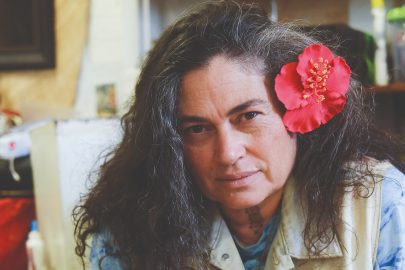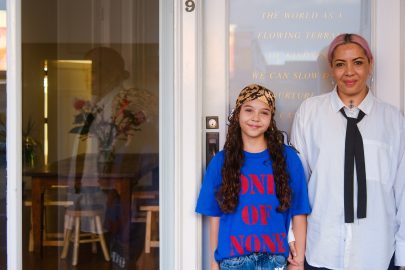Oct 9, 2014 Art
Light Show signals a big cultural shift for the Auckland Art Gallery.
Six daylight-fluorescent tubes are propped against a gallery wall: one in the far left corner, two in the centre, three in the far right. We read across them — one, two, three subsets of glowing sticks standing like sentinels, six feet tall. Each cluster has its own radiant intensity, but it’s the cumulative effect that matters most, because collectively they form one of the most radical moments in postwar sculpture.
When the American Dan Flavin first assembled them in 1963, he forced our attention away from the objects themselves to their effects on the environment around them — the environment that we, as viewers, also occupy. In that moment, everything changed: light became the technology through which we recognised vision not only as an observational tool, but as an embedded sense — just one part of a total, bodily experience of an artwork.
Flavin’s the nominal three (to William of Ockham) is the starting point for Light Show: a major exhibition that explores the light as sculptural form, opening this month at Auckland Art Gallery (AAG). It’s travelling here from London’s Hayward Gallery, where it was a huge success — one of those contemporary art exhibitions that manages to get rave reviews and big visitor numbers.
Auckland isn’t getting a watered-down version either; the list of works is almost identical, with only a couple missing through availability rather than cost issues. The AAG is also giving expat New Zealander Bill Culbert an expanded presence, supplementing the original show with a work from its own collection.
A big part of Light Show’s popularity in London was the eye-candy element; light sculpture can be extraordinarily seductive. Several leading UK critics noted this. In praising the exhibition for its theatricality, beauty and sensory extravagance, they were also slightly suspicious of how much they’d enjoyed it, asking where, in the end, they were supposed to find its argumentative edge.
On one level, it’s refreshing to encounter a curated exhibition that doesn’t hammer a polemical line. The title, too, is about as transparent as they come. But beyond the dazzle, Light Show does have some important things to say, in particular about the way light alters not just how we see art, but, as Flavin’s work illustrates, how we feel it.
Light is what makes vision possible, and yet it is immaterial; it travels in waves our brains reconfigure as image. For hundreds of years, artists have been fascinated with this. But it wasn’t until the technological advances of the twentieth century that they could move from simply representing light to actually using it.
The consequences of this were enormous; by diffusing the substance of sculpture through space, artists turned us from passive recipients of formal information to active, moving cogs in an aesthetic transaction. Neuroscience has changed the game, too; the more we learn about how our brains process light, the more artists are able to orchestrate disorienting, immersive encounters that test our perceptual limits.
Light Show presents the full gamut of these strategies. Flavin, for example, achieves dramatic spatial effects while making no secret of the commercial banality of his light sources. But in Wedgework V (1974), one of the other heroes of the medium, James Turrell, goes to huge lengths to disguise the technology — creating a total environment in which hidden projections trick us into experiencing light as solid form.
Anthony McCall takes this even further in You And I, Horizontal (2005), using haze machines and light projections to form cones and ellipses that make viewers feel as though they’re tumbling through space. And in Magic Hour (2004-2007), pictured above, David Batchelor takes on the history of light sculpture and the legacy of the readymade, using found lightboxes to cast halos that, when merged, approximate the mood of Las Vegas at dusk.
This is a small sample of the 20 or so installations in the show. It’s a knockout line-up: other artworld heavy-hitters include Olafur Eliasson, Jenny Holzer, Ceal Floyer, Fischli and Weiss, and Cerith Wyn Evans. While some have been shown in Auckland before (Wyn Evans was here as recently as April), it’s rare for local audiences to see so much exemplary work in a single exhibition. This, and the fact that the AAG is the first international destination for Light Show, says a lot about the institution’s changing ambitions under its new director, Rhana Devenport, and principal curator Zara Stanhope.
It also signals a big cultural shift within the institution. Until now, the new AAG has behaved much like the old one, largely telling the same story of New Zealand art. It has also has been taking the same encyclopaedic approach to presenting its collection, often resulting in boxy shows that carry the whiff of in-house curators flying solo, rather than working together. Light Show is breaking this formula.
It’s the first time since the gallery reopened in 2011 that an exhibition will run over two floors, suggesting that the gallery is becoming more flexible with its spaces and consequently less didactic. Its hope is that gallery-goers will start to understand that on one visit, they’ll encounter a huge show of international light art while on another, interwar modernism and, on another still, a retrospective by a New Zealand artist.
This gives them an incentive to visit every few months, rather than once every couple of years. It’s also a far more intelligent use of the building’s $100 million facelift.
A shared financial burden is significant here, too: after Auckland, Light Show heads to Australia and the Middle East, and Stanhope has indicated that collaborations like this are likely to start appearing regularly in the programme.
The more this happens the better, because it means Aucklanders will get to see good, well-researched international exhibitions properly, and at scale — shows that, in the past, might have made it only as close as Sydney or Melbourne.
Former director Chris Saines may have given Auckland a shiny new building, but Devenport and Stanhope are facing the tougher job of figuring out what to fill it with. Light Show looks to be a big step in the right direction.
Light Show: Auckland Art Gallery, October 11 to February 8.
aucklandartgallery.com/lightshow
Photo: Marcus J. Leith





